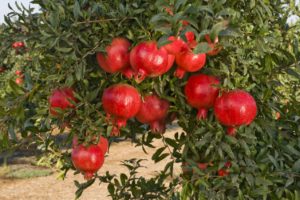General information:-
Pomegranate known as Anar in Hindi is commercial crop of India. Its origin lies in Persia. It is a rich source of carbohydrates, proteins, calcium, phosphorus, iron and vitamin C. Pomegranate eaten as fresh fruit also its juice is cool and refreshing. Along with juice, each and every part of pomegranate has some medicinal value. Its root and peel used to cure diarrhoea, dysentery and worm killing in the intestines. Its petals are used for preparing dyes. Maharashtra is major producer of Pomegranate. Other states like Rajasthan, Karnataka, Gujarat, Tamil Nadu, Andhra Pradesh, Uttar Pradesh, Punjab and Haryana are also cultivating pomegranate on small scale.
Soil:
It can be grown on variety of soils. For optimum growth and yield, it required deep loamy and alluvial soils. It is tolerant to loamy and slightly alkaline soils. It is also cultivated on poor soils. Also medium and black soils are suitable for pomegranate cultivation.
Popular varieties with yield:-
Bhagwa: Bigger fruit size, sweet, bold and attractive arils, glossy, very attractive saffron coloured thick skin. This variety was found less susceptible to fruit spots and thrips as compared to other varieties and matures in mid-October. It gives an average yield of 14.kg per tree.
Land preparation:
Plough the land for two - threetimes and bring soil to fine tilth. After then carry out planking operation to make land leveled and uniform.
Sowing:-
Time of sowing
Mainly sowing is done in December to January month.
Spacing
Optimum spacing is depending on soil type and climate. For Pomegranate planting, if square system of planting is adopted, use spacing of 4m x 4m.
Sowing Depth
For sowing, dug Pits of 60 x 60 x 60 cm size about a month prior to planting. Keep pits open under the sun for a fortnight. Then filled pits with top soil mixed with 20kg of farmyard manure and 1 kg of super phosphate. After filling pit, apply water. It settle down the soil.
Method of sowing
Transplanting method is used. Pomegranate is propagated through air layering method. Air layering is done in rainy season as well as in November-December month. For air layering, select one to two year old, healthy, mature shoot having length of 45-60cm with pencil thickness.
Seed:-
Seedling Rate
240 plants per acre.
Seedling Treatment
Before sowing, dipped seedling or cutting in IBA solution of 1000PPM@1gm/litre of water.
Intercrops:-
For initial two-three years, Intercropping is possible. Take vegetables, legumes or green manure crops as intercrop.
Fertilizer:-
Apply 5-6 kg Farm yard manure to one year old plant in December. Put Urea@50gm per plant every year in two equal splits. First dose is given in March month and second dose is given in April month. After 5 years start adding urea@250gm per plant.
Irrigation:-
In summer apply water at the interval of 10-15 days and in winter increase irrigation interval upto 20-25 days.
Weed control:-
To control weeds, mulching can be done. Along with weed control, it helps to conserved moisture and reduces evaporation loss.
Pruning and training:-
Training and Pruning help in growth of fresh healthy shoots. It removes old also disease branches and avoids overcrowding of branches. It also maintains proper shape of plant.
Plant protection:-
1.jpg
Pest and their control:-
Thrips: If thrips infestation is observed, take spray of Fipronil 80%WP@20ml/15Ltr of water.
Fruit Fly: It lay eggs on fruit rind/skin. After hatching they feed on pulp. Affected fruits get rot and then drop.
Keep cleanliness in field. At time of flowering and fruit development, take spray of Carbaryl 50WP@2-4gm or Quinalphos 25EC@2ml/Ltr of water.
Mealy Bug: Its nymphs, start crawling on trees and feed on young flowers. Also secrete honeydew like substance and black mould is developed on it.
As a preventive measure, fastened, 25cm width Polythene(400gauge) strip around tree trunk to stop ascent of nymphs before hatching of eggs in month of Nov and Dec. keep orchard clean. If infestation is observed, take spray of Thiamethoxam [email protected]/Ltr or Imidaclopird 17 [email protected]/Ltr or Dimethoate 30 EC@2ml/Ltr of water.
Aphid: Infestation of Aphids is observed take Spray of Thiamethoxam [email protected]/Ltr or Imidacloprid @0.35ml/Ltr of water.
Shot hole borer: If infestation is observed, to control take spray of Chlorpyriphos20EC@2ml/Ltr or Cypermethrin @60ml/150Ltr respectively.
Disease and their control:
Fruit spots: If infestation is observed take spray of Mancozeb or Copper [email protected]/Ltr of water.
Fruit rot: To control fruit rot, take spray of Streptocycline@50gm + Copper oxychloride@400gm/150Ltr of water. Take second spray 15 days after first spraying.
Wilt: If infestation is observed, do drenching of Carbendazim@5gm/5Ltr to infected plant also other plants surrounding diseases plants.

Harvesting:-
After flowering, fruits gets mature within 5-6months. When fruit changes its color from green to light yellow or red i.e fruits start ripening, it is optimum time for harvesting. Avoid delay in harvesting as it will lead to fruit cracking and thus leads to yield loss.
Post harvest:-
After harvesting, stored fruits in shades for a one week. It will help in hardening of fruit skin. So that less damage is observed in transportation. Fruits are graded according to weight.
